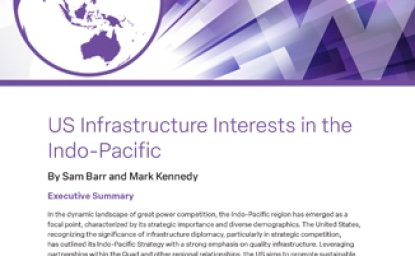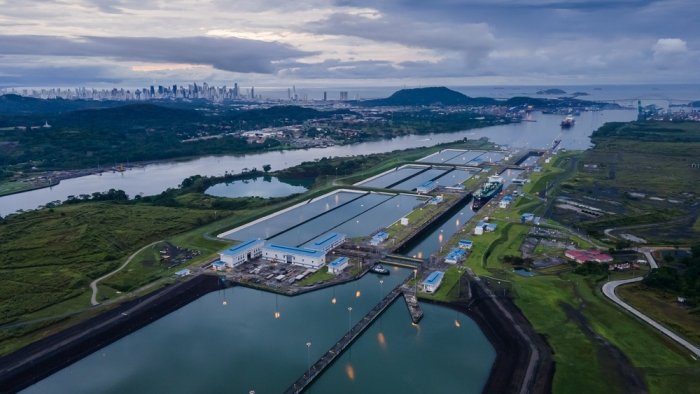For Want of a Nail
Mark Kennedy
Director, Wahba Institute for Strategic Competition, Wilson Center
The proverb reminds us that "For want of a nail, the kingdom was lost." Today, the United States faces mounting risks from the metaphorical lack of a nail—inadequate equity investment that could activate other capital to secure global investments critical to its national interests. More broadly and more effectively assisting emerging markets in meeting their own infrastructure needs is also a vital front in today’s strategic competition. Could the Sovereign Wealth Fund (SWF) that President Donald Trump is proposing be a solution? (Courtney Fingar and Dr. Jerry Harr suggest below that it could be.)
Consider the landscape:
- China’s Expanding Influence: China has financial stakes in nearly 100 ports worldwide, while the US has virtually none. Lea Thome makes the case that a SWF could help with maritime security.
- Control of Communications and Data: Huawei dominates 70% of Africa’s telecommunications backbone, granting China unparalleled control and access to data that could train its AI systems. Submarine cables are also being contested.
- Critical Minerals: Dr. Jojo Nem Singh makes the case below that a SWF could help extricate the US from China’s chokehold on critical mineral supplies.
- Competing in the Indo-Pacific: As Dr. Prashanth Parameswaran details below, the Indo-Pacific is the epicenter of today’s strategic competition and investments such as those made to keep the port near Subic Bay, the Philippines, in safe hands are vital.
China has achieved much of its dominance by subsidizing investments and leveraging equity, not just debt. In contrast, the US lacks an equivalent mechanism to counter Beijing’s Belt and Road Initiative (BRI). When the Overseas Private Investment Corporation (OPIC) was restructured into the US International Development Finance Corporation (DFC), it was heralded as a response to the BRI. However, restrictive budget rules imposed by the Office of Management and Budget (OMB) have constrained the DFC’s equity authority.
The Case for a Sovereign Wealth Fund
To meet the global demand for infrastructure and to safeguard US strategic interests, a stronger financial tool is urgently needed. A SWF could be that tool. Many assume SWFs are exclusively for investing excess surpluses. While many resource-rich states have a SWF (as Dr. Barry Rabe outlines below), fewer than half of the world's 100+ SWFs are funded this way (as Sarah Sobalvarro details). There are clearly many questions that need to be answered, as Dr. Klaus Larres suggests–how will it be funded, what will it invest in, how will it be governed?
A Nail to Secure America’s Future
The stakes are high. Strategic gaps in ports, telecommunications, undersea cables, and minerals expose the US to unnecessary risks. Whether by supersizing the DFC or creating a new SWF, the US must act decisively.
Perhaps a sovereign wealth fund is the "nail" America needs to secure its future. Without it, the foundation of US global influence may continue to erode, one missed opportunity at a time.
Building Bridges: How a US Sovereign Wealth Fund Can Strengthen Domestic and Global Infrastructure for Economic and Geopolitical Gains
Courtney Fingar
To be effective, a sovereign wealth fund (SWF) needs to have a clear mandate and well-defined priorities. In the case of the proposed SWF for the US, a key focus should be on infrastructure development—an area where more investment is needed domestically to bolster the country’s ageing infrastructure, but also internationally to shore up supply chains.
Globally, SWFs play an important role in infrastructure development by providing long-term capital for large-scale projects. Infrastructure is an attractive asset class for investment, offering stable returns with consistent cashflow.
Adequate, reliable infrastructure is essential to the US’ continued attractiveness as an investment destination, as well as its internal connectivity for commerce. To the extent it can be a vehicle for channeling increased investment in domestic infrastructure, a SWF can be beneficial.
As an international investor via a SWF, the US could enhance efforts to help spur development that will advance supply chain resilience. This requires coordination among the US International Development Finance Corporation, Export-Import Bank, private sector investors, and international partners. Building up infrastructure that increases connectivity—digital and logistical—and that supports industries such as manufacturing, renewable energy, critical minerals extraction, and semiconductors will strengthen supply chains to the benefit of US exporters, allies, and trading partners.
Investing in international infrastructure is also a means of extending geopolitical influence and strengthening economic ties with strategically important countries.
Strategic Wealth: The Case for a US Sovereign Wealth Fund
Jerry Haar
Sovereign wealth funds have existed for more than a century. These state-owned investment funds could offer the US several strategic advantages, particularly in stabilizing government finances, enhancing long-term economic competitiveness, and generating returns on national wealth. The principal advantages of such funds are fiscal stability and deficit reduction. The US could use surplus revenues (e.g., from energy production, trade surpluses, or specific taxes) to invest in assets that generate long-term returns, helping to reduce the national debt and fiscal deficits. The funds could also act as a stabilization mechanism during economic downturns by providing funding when tax revenues decline. Additionally, the fund could be used to invest in industries vital to national security and economic leadership, such as semiconductors, AI, clean energy, and infrastructure. Additionally, similar to Norway’s sovereign wealth fund, a US fund could grow over time and be used to fund pensions, social programs, or public infrastructure without raising taxes. Two more benefits of a fund are: enhancing global competitiveness, as strategic investments in technology, advanced manufacturing, and green energy would ensure the US remains an economic leader; and reducing dependence on foreign investment, since the US could finance more domestic projects and innovations without relying heavily on foreign capital. Norway, China, Abu Dhabi, Japan, and Saudi Arabia all have robust, well-performing sovereign wealth funds. Therefore, it behooves the US to give serious consideration (including ensuring safeguards and independence) to establishing such a financial vehicle.
Investing in Ports and Power: How a US Sovereign Wealth Fund Can Strengthen Trade, Security, and Global Partnerships
Lea Thome
The president’s announcement on the creation of a Sovereign Wealth Fund is one long-needed—and that other countries have already excelled in. A sovereign wealth fund can equip the US government with an arm to invest internationally complementary to the work of the US Development Finance Corporation, the US Export-Import Bank and the US Department of State.
In particular, an American Sovereign Wealth Fund can help boost American investment in overseas critical infrastructure—such as ports—to help strengthen US trade and national security while bolstering partnerships with other countries.
Other sovereign wealth funds by other countries have already done so. In 2021, Qatar through its Qatar Investment Authority was planning to invest $10 billion in US ports. In 2022, the Indonesia Investment Authority together with its port authority and DP World announced plans to “invest in the expansion of the Belawan port in Sumatra Island.” In 2011, Saudi Arabia’s Public Investment Forum joined forces with PSA International to form Saudi Global Ports Company, to invest into a “terminal at the King Abdul Aziz port in Dammam.”
Institutions like the DFC have already taken steps to increase American investments in ports and maritime critical infrastructure, but a gap for investment has remained. While the next ninety days will reveal the full plan and design of the Sovereign Wealth Fund, if designed carefully, this new fund will allow the US to leverage its wealth and investments in critical sectors overseas where the US can contribute alongside others.
How a Sovereign Wealth Fund Could Help US Win the Geoeconomic Competition in the Indo-Pacific Region
Strategic Wealth for Critical Minerals: Leveraging a Sovereign Wealth Fund to Reduce US Vulnerabilities and Counter China's Dominance
Jojo Nem Singh
Securing access to critical minerals while also reducing China’s dominance in mineral refining and processing are major priorities for the US. Given the variability in critical raw material (CRM) markets[1], specific commodities drive US vulnerability. To address this, the US government must conduct a thorough needs analysis and strategically leverage a soverign wealth fund (SWF) to finance investments in strategic minerals, particularly in upstream and midstream segments. With China imposing new export controls on antimony, tungsten, and iridium, further restrictions on mineral markets are likely.
The institutional design of a SWF should align with its objectives. Some SWFs act as financial reserves, insulating government revenues from political influence, while others serve as investment instruments[2] with distinct governance structures. The US Treasury would likely coordinate with the Export-Import Bank to identify investment strategies.
Most SWFs are structured to limit direct government control, with multiple oversight mechanisms to enhance accountability. However, these safeguards are only effective if policymakers recognize the importance of limiting discretionary spending and adhering to institutional rules.
How a Sovereign Wealth Fund Could Help US Win the Geoeconomic Competition in the Indo-Pacific Region
Dr. Prashanth Parameswaran
There are three key considerations with respect to the idea of a potential US sovereign wealth fund and its impact on geoeconomic competitiveness globally, as well as in the Indo-Pacific region: integration, focus, and management.
Regarding integration, any newly-created fund would be just one tool in the toolbox of US economic statecraft and would maximize its impact if and when it is deployed (ideally alongside US allies and partners). There are quiet examples of such US creative integration in the Indo-Pacific amid US-China competition. One case in point was the acquisition of an indebted Hanjin shipyard linked to the former Subic Bay naval base in the Philippines to fend off Chinese interests. Yet it is unclear how US partners would react to other attempts at integration, including linking fund financing to tariff revenue. To maximize integration, the administration would need to be clear about the balance of carrots and sticks it is offering in US geoeconomic engagement.
The second consideration is focus. A newly created sovereign wealth fund would maximize its chance of success if it were clear about its emphasis and value proposition in promoting US interests at home and competitiveness abroad. In just one example, officials in the administration of President Joe Biden had considered a fund amid various ideas to deploy more patient and flexible bridge financing to firms in targeted sectoral areas such as supply chain resilience. Targeted areas could reinforce impressive US economic performance that stands out among industrialized countries. That performance is alongside US gains in emerging technologies, such as artificial intelligence, as well as its status as one of the world’s biggest energy producers, each of which runs contrary to naysayer claims about American decline.
A final consideration is management. Sovereign wealth funds have seen their reputations take a hit due to mismanagement in some cases, including in the Indo-Pacific region. Chief among them was Malaysia’s notorious 1MDB scandal, which helped oust a past regime and eventually saw the country’s current leader Anwar Ibrahim preside over the country. The US system already has mechanisms in place to prioritize accountability, as well as checks and balances. Nonetheless, there will need to be proper attention to ensuring that safeguards are in place to minimize future mismanagement that could taint its effectiveness.
Does Establishing a SWF Make Sense?
Klaus Larres
It is difficult to keep pace with the plethora of executive orders President Donald Trump has issued during the first weeks of his second administration. Many of his decrees have been controversial and quite a few have been challenged in the courts. Yet there are some executive orders that are potentially more imaginative, ambitious, and forward looking than the vast majority of orders announced thus far. They deserve serious examination, including the executive order President Trump issued on February 3, 2025, to establish a US Sovereign Wealth Fund (SWF) of more than $2 trillion in assets. The president requested his Treasury and Commerce secretaries to report back within 90 days with plans to set up such a SWF. In all likelihood, a new SWF would require an Act of Congress. Yet the Republican controlled Congress would likely not stand in the way of setting it up if the president pushed sufficiently hard for it.
At the most basic level, a SWF is a state-owned investment fund that manages a country’s financial assets for profit to build up a ”nest egg” for long-term financial stability, independence from foreign influence, and for the well-being of future generations. Yet a SWF also might come in handy in case of serious financial emergencies or for financing political priorities, including spreading a country’s global influence, as China frequently does with its China-Africa Development Fund.
Some 90 countries around the world have their own SWFs, with total assets of more than $8 trillion. The largest SWFs are in Norway and China, which have $1.74 trillion and $1.33 trillion (respectively) in assets. The United Arab Emirates, Saudi Arabia, Kuwait, Abu Dhabi, and Singapore also have sizable SWFs. In fact, the idea of establishing a SWF for the US is not entirely new. The Biden administration toyed with the idea, and there are 21 US states that have set up SWFs (with “sovereign” broadly interpreted) at the state level. The oldest one dates to the mid-19th century. Among the largest SWFs in the US are the ones owned by Alaska, North Dakota, and Texas. Most SWFs around the world and in the US are based on surplus revenues from the extraction and export of commodities, such as oil, gas, and minerals, or from foreign exchange reserves derived from exports. They are also sometimes funded from tax revenue surpluses.
The most pressing issues that need to be addressed when considering setting up a SWF by the federal government is how to fund such a massive SWF and how to govern it professionally to avoid corruption, nepotism, and political partisanship and interference in how they run. The latter plagued the SWFs of Malaysia and Venezuela, which eventually collapsed.
How would a US SWF be funded?
In view of the large US budget deficit (nearing $2 trillion in 2025) and the unwillingness of policymakers in the executive branch and in Congress to raise taxes for a SWF or to raise more debt, President Trump has suggested that import tariffs imposed on foreign countries and companies would capitalize a new US SWF. This is controversial and might well be impossible, as the revenues from tariffs may be significantly lower than the administration anticipates. The president has also suggested that tariff revenues might be able to replace the federal income tax, which is equally unrealistic. Tariffs on foreign goods can’t possibly be the solution to every financial problem the government faces or be the way to capitalize new US investment vehicles.
Still, capital could be raised by selling (or leasing) the huge amounts of federal land, properties, infrastructure assets, mineral rights, and services that the US government owns. Yet would it be wise to invest proceeds from these sales and leases into a new SWF instead of first paying off America’s huge and unsustainable budget deficit? In any case, a portion of the profits of a US SWF could certainly be used to pay down the national debt. This would in turn help to stabilize the finances of the US government and improve the country’s long-term economic stability.
How would a US SWF be invested and how should it be governed?
To avoid financial corruption and political interference, it would make sense to keep the investments of a new SWF concentrated on global markets rather than domestic ones, where US government investments could have a hugely distorting effect. The fund should also be a passive investor rather than invest and assume direct ownership stakes in US corporations and companies. It would also be wise for the SWF to focus on maximizing returns by perhaps investing in potentially high-reward businesses, such as in the technology, AI, and new energy sectors, rather than on guiding companies in a certain direction.
The SWF also should be run by an independent and neutral body of advisers and trustees. To some extent, the model could well be the Federal Reserve. The SWF leadership body should be independent from both the different priorities of presidential administrations and from the spending priorities of Congress and its members in both chambers. This also means the investments of the SWF should happen in transparent and responsible ways within a firm and strict legal framework.
James Broughel of Forbes Magazine wisely called for “regular audits, clear reporting requirements, and strict oversight mechanisms” as well as “annual reports to Congress, independent financial audits, and open investment disclosures” to make sure that a new American SWF “remains a responsible steward of public wealth.” This would also have to include a strict annual withdrawal cap to reduce the temptation of Congress to use the fund for immediate short-term finance requirements. Thus, adherence to strict financial guidelines and a tight governance structure are essential to ensuring the success of a potential US SWF.
Outlook
President Trump’s executive order to set up a US Sovereign Wealth Fund makes sense in principle. However, whether it does so in practice depends on how a SWF of $2 trillion will be capitalized without burdening the US taxpayer, and whether a strict and transparent governance structure within a strict legal framework can be agreed to by Congress and imposed on a SWF. Cleary, much work still needs to be done before any new US SWF will see the light of day.
Sovereign Wealth Funds in American States
Barry Rabe
Sovereign wealth funds are not operated exclusively by national governments, as demonstrated by their presence in many American states, Canadian provinces, and Australian states. Sub-federal funds are commonly linked to fossil-fuel production, whereby states designate some portion of severance tax or royalty revenues for long-term investment. More than half of American states maintain energy severance taxes or royalties, with 10 having established one or more related funds. The largest ones operate in Texas, Alaska, and New Mexico (between $54 billion and $96 billion per state in 2024), although some of the most rapid recent growth has occurred in North Dakota ($11 billion).
Such funds were developed during three distinct periods. Two were created in Texas during the mid-1800s, followed by six more during the 1970s and 1980s, and three more between 2008-14. All those established through constitutional amendment have endured. West Virginia’s fund, created through a 2014 statute, was later repealed. State adoptions were prompted by a desire to secure permanent value from extracted non-renewable natural resources; funds sought to moderate state revenue swings during boom-and-bust production periods and reduce single-industry fiscal dependence. However, several production states rejected proposals to establish such funds in recent decades, reluctant to curb immediate revenue use.
Most states set and have sustained clear initial plans for revenue investment and allocation. Following Texas’ lead, this most frequently supports public education but also includes such alternatives as annual citizen dividends (Alaska) or biennial legislature decision (North Dakota). Some states have designed funds to mirror global best practice models, particularly those in Norway. Most funds and revenue-use plans have remained quite durable across decades, reflecting their constitutional foundations, reputations for prudent management, and popularity of benefits linked to revenue use. Collectively, they offer many insights for potential federal consideration.
International Sovereign Wealth Funds Have a Robust History
Sarah Sobalvarro
A sovereign wealth fund (SWF) is generally described as an investment fund created by a government to maximize its return on revenue. A SWF can serve multiple purposes, including stabilizing a country's economy and insulating its budget, preserving wealth for future generations, reducing the financial burden of holding reserves, allocating resources for development projects, and supporting future pension obligations.
According to the International Forum of Sovereign Wealth Funds, there are more than 100 funds managing more than $9 trillion in assets globally. The Sovereign Wealth Fund Institute lists the top SWFs (calculated by total assets) as the Norway Government Pension Fund Global, the China Investment Corporation (CIC), the State Administration of Foreign Exchange (SAFE) Investment Company (China), and the Abu Dhabi Investment Authority.
Many SWFs are created from excess revenue, with more than 45% of funds formed from natural resource earnings. Such is the case with Norway’s sovereign wealth fund, which was founded in 1990 from revenue generated by oil and gas exports. The fund is meant to stabilize Norway’s economy, provide for future generations, and support government pensions. Investments include foreign equity, real estate, and energy infrastructure. It is managed by Norges Bank, with direction from Norway’s Ministry of Finance.
Similarly, the United Arab Emirates’ sovereign wealth fund, the Abu Dhabi Investment Authority (ADIA), was established with funds generated by the UAE’s indigenous oil reserves. It was created in 1976 to promote economic stabilization and to maintain wealth for future generations. It is independently managed by a board of directors and internal and external personnel. The government of the Emirate of Abu Dhabi provides ADIA with funds to invest, and ADIA personnel invest them in a variety of assets, including infrastructure, equities, and renewable energy.
CIC and SAFE Investment Company are both SWFs for the government of China. Unlike Norway or the UAE’s sovereign wealth funds, these funds were not created out of excess revenue. Instead, both were formed from bonds issued by the Chinese treasury to CIC and SAFE, generated by the money created from China’s foreign reserves. CIC was established in 2007 to facilitate foreign equity investments. It is chiefly intended to diversify foreign exchange reserves. Management of the fund is the responsibility of the CIC Board of Directors, who are appointed by China’s State Council. CIC invests in various assets, including natural resources and domestic tech companies such as Alibaba. The SAFE Investment Company was formed in 1997 to manage China’s foreign equity investments and reduce fluctuations of the yuan against the dollar. It is managed by personnel from China’s State Administration of Foreign Exchange, a subsidiary of China’s Central Bank.
[1] According to UNDESA (2025, 7), the market for key energy transition metals is only USD 325 billion which is equivalent to the iron ore market and only 5% of the global oil and gas market. There is wide variation among critical minerals as well: copper has a market size of over USD180 billion while lead is as small as USD 10 billion.
United Nations Department of Economic and Social Affairs. ‘Harnessing the Potential of Critical Minerals for Sustainable Development’. In World Economic Situation and Prospects 2025, Chapter 2. United Nations Publications, 2025.
[2] For example, Norway and UAE have huge natural resource funds (a sub-category of SWFs—oil revenues were the main source of income) that are overtly used for long-term investments and economic diversification of state assets.
Authors


Principal, Fingar Direct Investment; Contributor, Forbes

Professor of International Business and Executive Director for the Americas, College of Business, Florida International University


Assistant Professor, International Institute of Social Studies, Erasmus University Rotterdam

CEO and Founder, ASEAN Wonk Global, and Senior Columnist, The Diplomat

Richard M Krasno Distinguished Professor in History & International Affairs at the University of North Carolina at Chapel Hill

Arthur Thurnau Professor Emeritus of Environmental Policy, Gerald Ford School of Public Policy, University of Michigan

Wahba Institute for Strategic Competition
The Wahba Institute for Strategic Competition works to shape conversations and inspire meaningful action to strengthen technology, trade, infrastructure, and energy as part of American economic and global leadership that benefits the nation and the world. Read more

Explore More
Browse Insights & Analysis
US Infrastructure Interests in the Indo-Pacific





